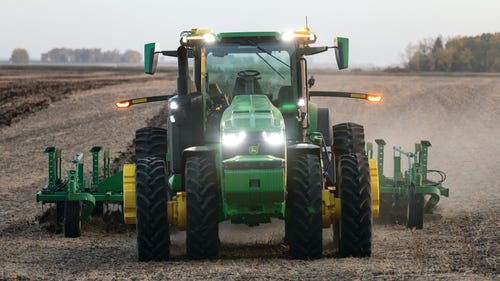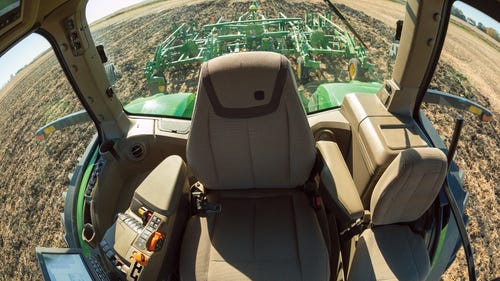The Automated Farm, from Field to Office
Everything in Agriculture is getting automated, even office tasks. Here’s a look at the Farm’s new office.
September 29, 2023

Lee Johnson, engineering manager for technology development, John Deere
Flexible work, hybrid schedules, remote-work models — it’s guaranteed you’ve heard these words over the past few years. Work environment decisions are top of mind for those in the corporate world, as these decisions impact employee retention and company makeup. But imagine working in an industry that not only requires you to work in person every day but that if you didn’t, the world wouldn’t have the necessary means to comfortably survive. Sounds like a lot of pressure, right?
That’s the life of a farmer. Farmers are the backbone of how we feed, clothe, and fuel the world. And as our world population grows, so does the demand for these necessities. This means farmers don’t always have the luxury of a flexible work schedule.
Not all offices consist of four walls. A farmer has many offices that go beyond a physical building. One of farmers’ most important “offices” is the cab of their tractor — also known as the Swiss Army Knife of agriculture because of the various tasks it’s used for. As the complexities of farming and agriculture grow — like the need to increase yields with less farmable land — the tractor cab has steadily advanced. Traditionally a way to protect the operator from dust, dirt, and harsh temperatures, the cab has advanced over the years to provide farmers with high-tech capabilities and support.

The Autonomous Farm
One of those capabilities is self-steering technology. Since the first tractor, farmers have had the task of manually steering their machines for upwards of 12 hours a day. Imagine a 12-hour daily road trip through farmland? Exhausting. The introduction of GPS technology more than two decades ago eased this manual burden, enabling the machine to know exactly where it was in the field and automatically steer the desired path on its own. Today, farmers utilize this option within most machinery, whether planting seeds, caring for plants, or harvesting crop.
Like a laptop or monitor at your desk job, the cab also features digital displays that hold the most important asset of day-to-day operations: data. Sensors, artificial intelligence, and machine learning are now intertwined within agricultural machines, making them complex. Digital displays within the cab – picture a ruggedized tablet – provide farmers with key insights on their land while they’re in the field.
Oftentimes displayed in the form of a map with colors to indicate differing data points, the displays project information like where and when seeds were planted and fertilized, the amount of chemical applied, the varying harvest yields across the fields, and more. Having easy access to this information helps farmers reduce their time in the cab and greatly improves their ability to make real-time decisions. This data, when uploaded to the cloud, also lets farmers compare operations year-over-year to make changes for the future and ultimately boost yields.

The Autonomous Farm’s Office
We can’t be sure what the future of the tractor cab will look like, but we do know that agricultural workplace flexibility is on the horizon.
While these cab components make farmers’ experiences better, they don’t diminish the challenges and time constraints that come along with the profession. Often the most important place for the farmer to be is not in the cab. Sometimes it’s in the field checking how well the machine is operating. Sometimes it’s being in the next field performing a different task or even back at the farm. New autonomous technology reduces the time farmers need to be in the cab or even in the field.
Today, farmers are starting to control autonomous tractors via an app on their phone or tablet, which lets them start, stop, adjust, and monitor tractor operations from anywhere. This is a game-changer for farmers, as their days can be more effective, allowing for more time spent with family, friends, or other “traditional” office tasks. Plus, in an industry whose labor pool is growing at the lowest rate compared to all other industries, this releases the burden on farmers to expand their employee base.
Farmers will likely never have the corporate hybrid work schedule, but they will have the ability to use autonomy to help them focus on their business’s bigger picture such as planting seeds at the optimal time, managing their farm’s logistics, and mitigating skilled labor shortages. As our demand for food, clothing, and fuel rises, farmers must adapt to meet these needs. That’s why autonomous and precision technologies are transforming and evolving to support this critical workforce – a workforce crucial to our survival.
You May Also Like



